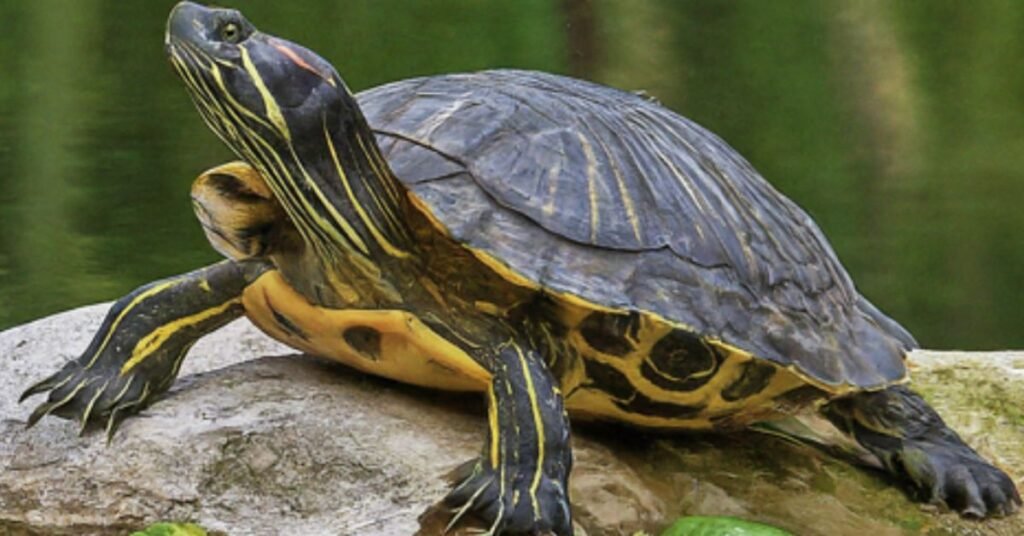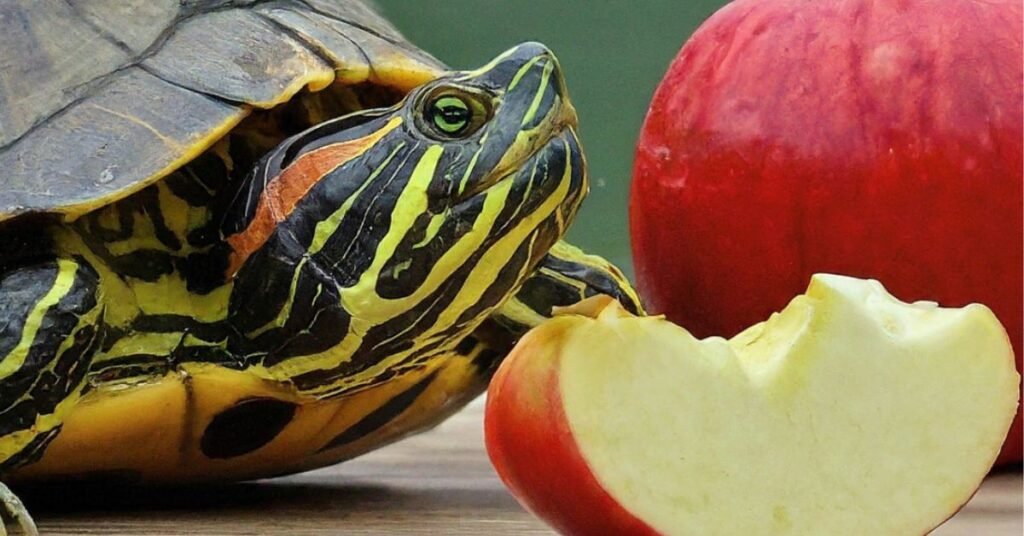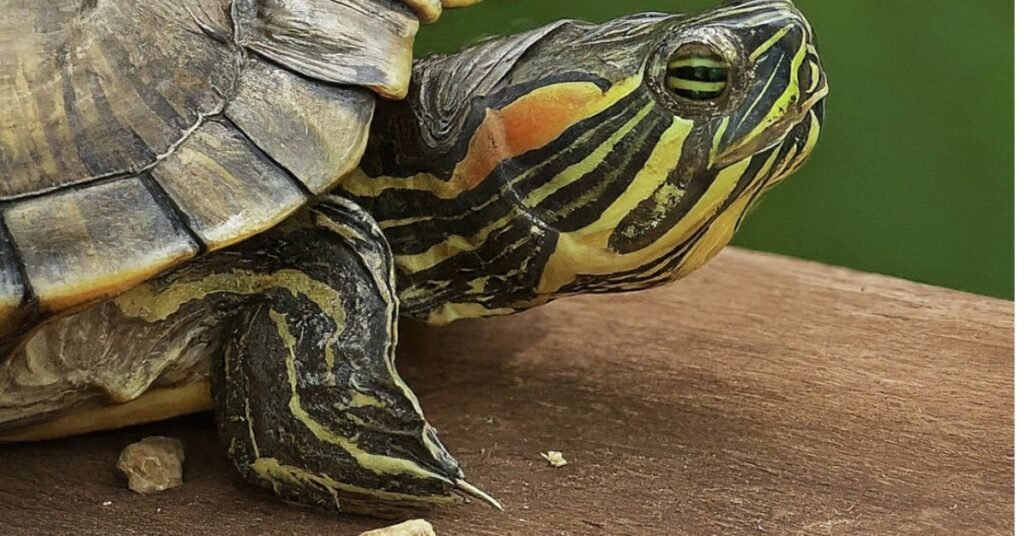Among the 356 turtle species, yellow-bellied sliders are one of the most popular pets. So, if you own one of these turtles, this question should be a common one for you: “What do yellow belly turtles eat?” They have diverse dietary needs that change as they grow. The most common habit of turtles’ diet is omnivores and yellow-bellied sliders also follow this diet.
It means that they eat both plant-based (vegetables, fruits, leafy greens) and meat-based diets. In the wild, they eat aquatic vegetation, insects, small fish, and sometimes carrion. In captivity, it’s essential to provide a variety of leafy greens, fruits, and protein sources like commercial turtle pellets. So, let’s take a look at “What do yellow belly turtles eat?” and learn about their dietary needs and habits.
Table of Contents
What Do Yellow Belly Turtles Eat?

What they eat depends on where they live. In the wild, Yellow-bellied turtles adapt their diet based on their environment. In captivity, you have to make sure to serve a balanced diet.
Aquatic Vegetation
In the wild, yellow-bellied sliders are like underwater salad bars. They love munching on all sorts of yummy aquatic plants like
- Algae
- Duckweed
- Hydrilla
- Hornwort and
- Water lettuce
These plants are plentiful in their natural habitat, like ponds and rivers. These diets give the yellow belly turtles the vitamins and minerals they need to grow strong and healthy.
Small Aquatic Animals
As we said, yellow belly sliders are omnivores; they eat meat meals besides plant food. They also love to snack on small aquatic animals, like a protein meal under the water. Here are some of their tiny prey options:
- Mosquito larvae
- Daphnia (water fleas)
- Aquatic worms
- Tadpoles
- Small snails
Fish and Carrion
Sometimes, yellow-bellied turtles eat fish and carrion. They do not actively hunt large prey but eat small fish and scavenge dead animals. The opportunistic feeding ensures they get enough protein and variety in their diet.
Seasonal Variations
Like us, yellow-belly turtles’ diets change with the seasons. As they find food from their surroundings, they grab what seasons have the best food for them. The availability of specific food sources varies at different times of the year.
For instance, they might eat more aquatic plants in spring and summer when they are more abundant. They might also shift to eating more animals and carrion in other seasons.
Leafy Greens
- Kale: Kale is packed with vitamins A, C, and K, as well as calcium, which is crucial for healthy shell development. Offer it 2-3 times a week.
- Collard Greens: Collard greens boast an excellent balance of vitamins A, C, and K, along with calcium and fiber. They’re a great source of roughage to aid digestion.
- Mustard greens: These are a good source of calcium and vitamins A, C, and K.
- Turnip greens: Another option is rich in calcium, vitamin A, and fiber.
- Bok choy: This veggie is full of vitamin C and calcium, but be careful because it contains some goitrogens, which can interfere with thyroid function.
- Escarole: A good source of vitamin A and calcium, with a slightly bitter taste that some turtles enjoy.
- Watercress: It’s high in calcium and vitamin A, but be aware of its high oxalate content. Offer it occasionally.
- Dandelion Greens: They’re rich in vitamins A, C, and K and also contain calcium. For a balanced meal, mix dandelion greens with other greens and serve them occasionally (1-2 times a week).
Colorful Veggies
Just like leafy greens, offer a variety of colorful veggies for extra nutrients:
- Carrot Crunch: Vitamin A for healthy eyes. (Grated, 2-3 times/week)
- Squash Symphony: Vitamin C and fiber. (Cooked/shredded, rotate types, 2-3 times/week)
- Bell Pepper Bonanza: Vitamin C boost. (Chopped, remove seeds, 1-2 times/week)
- Green Bean Goodness: Fiber and vitamins. (Chopped, 1-2 times/week)
- Snap Pea Surprise: Vitamin C and K. (Whole or chopped, 1-2 times/week)
- Butternut Bonanza: Vitamin A and fiber. (Cooked/mashed, occasional)
- Sweet Potato Sunshine: Vitamin A and beta-carotene. (Cooked/mashed, occasionally)
- Mushroom Medley: Vitamins and minerals. (Chopped, occasional)
Remember: Introduce slowly, wash thoroughly, chop appropriately, and offer in moderation!
Fruity Treats (But Not Too Many!)
Fruits can be a sweet treat for your yellow-bellied slider, but just like with cookies for us, they should be enjoyed sparingly. Here’s a fruit basket of yummy options:
- Berries: Blueberries, raspberries, and strawberries are all turtle-approved in moderation. These are packed with vitamins and antioxidants, and their smaller size is perfect for snacking. (1-2 times/week)
- Apple: Chopped apples offer less sweetness and vitamin C. Just be sure to remove the seeds, as they can cause digestive issues. (1-2 times/week)
- Melon Munchies: Cantaloupe and honeydew melons provide a hydrating and refreshing treat. However, due to their higher sugar content, limit these.
Fruits to Avoid: Steer clear of grapes, raisins, prunes, and citrus fruits like oranges and lemons. These are high in sugar or citric acid, which can harm your turtle’s digestive system.
Limit fruits to 1-2 times a week as a special treat.
Protein Power-Ups (Pellets or Meat/Fish)
For protein, special turtle pellets are the most suitable choice. They’re made just for turtles and have all the nutrients they need to grow strong muscles and a healthy shell.
You can also give them a little feeder fish or cooked lean meat, but make sure it’s fat-free, boneless, and plain (no spices or sauces!). Protein should be offered daily for adults and more frequently for growing babies.
Supplements
Calcium and vitamin D3 supplements are like magic vitamins for turtles. They help turtles absorb calcium from their food, keeping their shells healthy and preventing soft shells.
Make sure to consult your veterinarian about the proper dosage and frequency for your specific turtle.
Baby Yellow Belly Turtle Diet
The following are the baby Yellow Belly Turtle diets that you should be aware of.
Meat and Protein
Baby yellow-bellied turtles need more protein than adults. They should eat primarily insects, worms, meat, and small fish.
Live food options include brown crickets, black crickets, mealworms, and earthworms. Dried versions of these insects can also be provided if live food is not available.
Slowly Introduce Vegetables & Fruits
As baby turtles grow, fruits and vegetables, you can gradually introduce them into their diet. In the beginning, their diet should be protein-rich, but as they get older, they can switch to an herbivorous diet like adults.
Pellets
You can feed them commercial turtle pellets to your baby turtle. They should be given in moderation, though, so they get a balanced diet of natural foods.
The Yellow Belly Slider Feeding Schedule and Quantity

Baby Sliders
Little sliders are growing machines, so their diet needs protein.
- Feeding Schedule: Aim to feed your baby slider 2-3 times a day, spaced out evenly throughout the day.
- Portion Size: Offer a total amount of food roughly the size of their head at each feeding.
- Protein: Most of this food (around 70-80%) should be high-protein options like insects (crickets, mealworms), worms (earthworms, bloodworms), or small fish.
- Nutrient Boost: Supplement their diet with a small amount (20-30%) of special turtle pellets formulated for juveniles.
Adult Sliders
As your slider gets older, their taste buds change. They become more vegetarians.
- Fewer Feedings: Adults don’t need to eat as often. Offer them a yummy salad (leafy greens, some fruits) about the size of their head every 2-3 days.
- Veggie: The majority (around 60-70%) of their salad should be leafy greens like kale, collard greens, veggies, and other healthy options we discussed earlier.
- Fruity Fun: Add a small amount (around 10-15%) of chopped fruits like berries or apples for a sweet and refreshing treat.
- Protein: Offer some special turtle pellets or lean meat occasionally (around 15-25% of their diet).
Common Yellow Belly Slider Feeding Mistakes

There are some things to consider and avoid while serving food to your yellow belly slider.
Overfeeding
One of the most common mistakes when feeding yellow-bellied slider turtles is overfeeding.
Just like us, sliders don’t need too much food. Too much yummy stuff can make them overweight and even damage their shells. Follow the “head-size rule” and feed them the right amount for their size, especially adults who only need to eat every few days (2-3 days).
Improper Diet Balance
Baby sliders need more protein to grow strong, while grown-ups need a more plant-based diet to stay healthy. Don’t give too much protein to adults, and make sure young yellow-bellied sliders get enough. You can think of it as a combination of salad and protein.
Lack of Variety
Don’t give your yellow belly slider the same boring food every day. Like us, they need a variety of things to eat. Offer them a mix of leafy greens, fruits (not too much!), insects, and special turtle pellets. This keeps them interested in their meals and gives them all the nutrients they need to be happy and healthy.
Case Studies and Expert Tips About Yellow Belly Slider Diet
Veterinarian Advice
According to vets and turtle experts, young turtles need more protein for growth, while adults need more greens. Calcium and vitamin D3 are crucial for healthy shells, and overfeeding can lead to obesity. It’s best to give turtles only what they can eat and avoid human junk food.
What Turtle Owners are Saying?
We have thoroughly researched many yellow-belly slider owners’ feeding tips. For example, a yellow belly slider owner’s weekly routine includes leafy greens, occasional fruits, and proteins like earthworms and fish. She also includes commercial pellets and calcium supplements in her turtle diet.
Another owner noticed his yellow-bellied turtle was sluggish due to a boring diet. He then mixed in new aquatic plants and proteins, which perked up their turtle’s activity.
Read More: Can Turtles Eat Mushrooms?
Bottom Line
Yellow belly sliders aren’t picky eaters, but they do change their preferences as they grow. As hatchlings, they need more protein, like cricket, different types of worms, cooked meat, fish, and pellets. But as they mature, their tastes shift towards more veggies.
Leafy greens become the main course, with some fresh fruit in moderation. Always serve the right portions; too much feeding can put the yellow-bellied slider’s health at risk.
